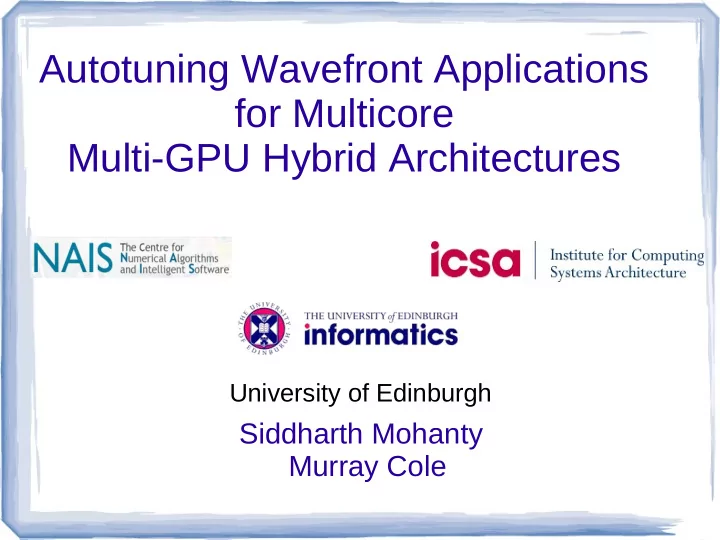

Autotuning Wavefront Applications for Multicore Multi-GPU Hybrid Architectures University of Edinburgh Siddharth Mohanty Murray Cole
Agenda (1:00) Wavefront Pattern (1:00) ● Wavefront Applications (0:30) ● Implementation Strategy + trade-offs (4:30) ● Experimental Programme (1:30) ● Platform And Parameters (1:00) ● Exhaustive Search Results (2:00) ● ESR : Best Points Performance (1:00) ● ESR : Best Points Sensitivity (1:00) ● Autotuning Model (1:00) ● Autotuning Results (1:30) ● Q&A (4:00) ●
Wavefront Pattern (0:30) (c) (c)-Dios, A.J et al."Evaluation of the Task Programming Model in the Parallelization of Wavefront Problems," (HPCC), 2010, IEEE
Wavefront Applications (0:30) Nash Equilibrium : A game-theoretic problem in economics, characterized by small instances ● but a very computationally demanding kernel. The internal granularity parameter controls the iteration count of a nested loop. Biological Sequence Comparison : A string alignment problem from Bioinformatics, ● characterized by very large instances and very fine-grained kernels, varying with detailed comparisons made. (a) (a)- http://en.wikipedia.org/wiki/SmithWaterman_algorithm
Implementation Strategy (4:30) Dual GPU MultiCore Wavefront Framework
Experimental Programme (1:30)
Platforms and Parameters (0:30)
Exhaustive Search Results (ESR) (2:00)
ESR : Best Point Performance (1:00)
ESR : Best Points Sensitivity (1:00)
Autotuning : Model (1:00)
Autotuning Results (1:30)
Thank You
Appendix :Tuning Challenges Problem size ( dim ) large enough to justify parallel computation in GPU (smaller sized ● problems can be computed quicker in the faster CPU cores) Granularity of task ( tsize ) high enough for computation to dominate over the cost of starting a ● GPU and the communication overhead of transferring data between GPU and CPU. Communication cost increases with increase in data ( dsize ) being transferred ● Dual GPUs have the additional overhead of exchanging neighbouring data between ● themselves every few iterations ( halo swapping). Halo swaps will decrease with increase in halo size but this has to be traded against ● redundant computation, which starts affecting performance with increase in granularity of task GPU tiling ( gpu-tile ) leads to reduction in the number of kernel calls but this has to be traded ● against the additional cost of synchronizing work items within each work group. When computation dominates over communication anyway, time spent in kernel calls no ● longer matters and gpu tiling may prove to be counter productive The type of system affects the performance : ● - fast GPU coupled to a slow CPU means data will mostly be offloaded to the GPU, meaning more diagonals in the GPU ( band sizes) with CPU tiling having negligible effect. - fast GPU + fast CPU would similarly mean lower band sizes
Appendix : Framework Interface
● Appendix : TBB/Omp/baseline vs skeleton ● ●
Appendix :Previous Autotuning Performance ● Synthetic Application – note varying colour key 1
Appendix : Previous Summarised Results ● Overall Average Performance 1
Recommend
More recommend